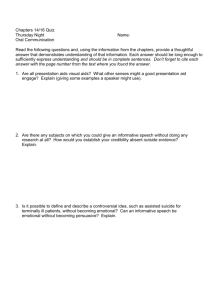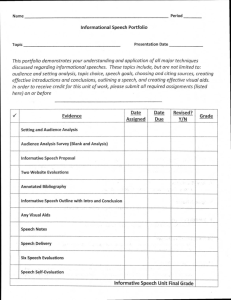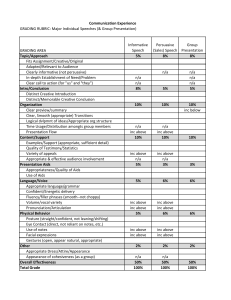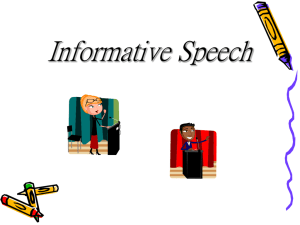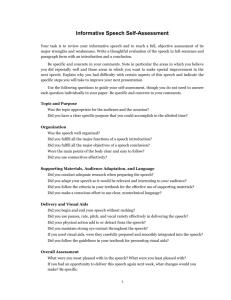W6-Ch 4-Speaking to inform - oral
advertisement
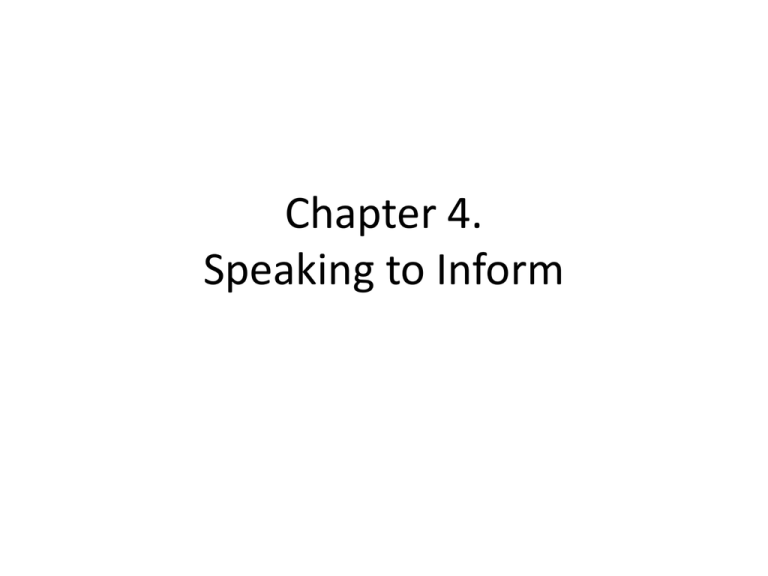
Chapter 4. Speaking to Inform About Informative Speech • Any speech is an informative speech if it presents information to an audience. • When do we make informative speech? • All the time. • What is the goal of giving an informative speech? • To state ideas simply, clearly, and interestingly. Preparing for the Informative Speech • • • • • • • Blueprint: a vision of what you want to build. Analyzing your audience Choosing your topic Narrowing your topic Gathering information Preparing visual aids Organizing your speech Step 1: Analyzing your audience • Demographic: the population’s needs, interests, knowledge. – Age range – Gender – Occupation(s) – Economic level(s) – General background • P.63-64: Personal Information Survey. • P.65: Analysis of Audience Step 2: Choosing your topic • Choose sth that you know a lot about or sth that really interests you. – An experience that you remember vividly and are enthusiastic about. – Sth you care a lot about. – Sth at which you are skilled or experienced. – Sth about which you are knowledgeable. Step 3: Narrowing your topic • Not to tell everything you know about the topic. – It’s impossible to say everything in a short amount of time. – Your audience can’t remember too many details after a speech. • How to narrow an informative speech topic effectively? – A good informative speech topic is specific, contains only one idea, and is achievable. • P.68. Evaluate topics. Step 4: Gathering information • Two ways to look for material for your speech: – Within yourself – Outside yourself • Interview • Library and Internet research • Find more information than you can use! – Choose what to include instead of stretching the facts to fill time. – Extra knowledge may be helpful for Q&A session. • Interview – Open-ended questions – Closed-ended questions – Scale questions – Directive questions – Multiple-choice questions • Library search – Bibliography note cards Step 5: Preparing visual aids • Why use visual aids? – Help make a speech clear and interesting. – Add variety, capture attention, illustrate concepts, and provide entertainment. • Visual aids are helpful in three ways: – They help the speaker get organized. – They help the audience understand the information. – They help the audience remember the speech. • Chalkboard • Poster – With charts or graphs – With words or phrases – With drawings • Objects or models • Audiovisual equipment (overhead projector or opaque projector) – Slides – Films – videotapes • Handouts • Tips of using visual aids: – Use visual aids that are large enough for everyone to see. – Do not pass out objects or papers during your speech. – Keep charts, maps, and graphs very simple. – Look at your audience, not at your visual aids. – Put your visual aids away after you have finished using them. – Practice using your visual aids with your speech before you actually deliver it. Informative Speech Schedule • 4/2-4/8: Find a topic for your informative speech. Prepare your proposal. • 4/9 & 4/16: Present your proposal in class. You topic needs to be approved by the whole class; otherwise you need to change topics. • 4/16-4/22: Preparation. • 4/23: Informative speech presentation. Topic • Main goal: sth related to culture. • Three standpoints to take: – Sth globalwide Universality – Sth which others have but we don’t Specificity – Sth we both have but different Comparison Proposal for Informative Speech • Central topic: Culture – To give your own definition of “culture.” • Personal topic (A rough direction is fine. No need to give a specific “title” at this stage.) – To explain the reasons why the topic you choose fits your definition of “culture.” • Rationale – To briefly introduce the topic, and tell the possible directions you are going to probe into the topic. – To explain the importance of knowing this topic.

